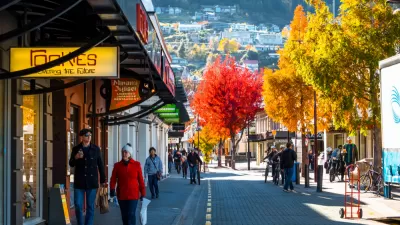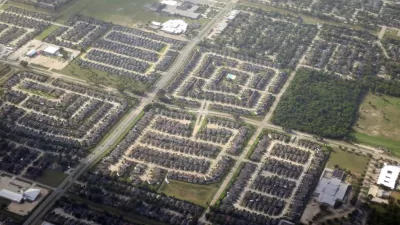Density -- either high or low or somewhere in the middle -- is a key defining element of our cities. In this essay, Witold Rybczynski looks at the relative densities of U.S. cities and suggests that things may start to change subtly.
"There are a number of ways in which American cities could become denser. In vertical downtowns, tall buildings could simply get taller, or older office towers could be converted to residential use, as has happened in some business districts. The most common form of urban densification is the conversion of disused waterfronts, decommissioned Navy yards, and obsolete industrial areas into housing and office developments, an attractive strategy since it does not displace existing residents. In older city neighborhoods, taller structures could progressively replace three- or four-story row houses and low apartment buildings, though community resistance makes this a slow process.
Suburban densification is more challenging. In Philadelphia, where I live, it was common practice in the mid-20th century to subdivide large suburban estates into communities of single-family houses, but such open spaces in the suburbs are increasingly rare. Neighborhoods of single-family housing can be made denser by building clusters of smaller houses on what were previously large single-house lots, or by introducing row houses or low-rise apartment buildings. Both strategies involve radical changes to neighborhood identity, however. Perhaps the greatest challenge will be to increase density in the large planned-unit communities that have proliferated in the past few decades. In these, any change is constrained by homeowner associations in which even a small minority of members can effectively block alterations they find objectionable."
In this discussion of density and cities, Rybczynski wonders if spread-out urbanity will continue, if urban density will take hold, or if it will be a combination of the two.
FULL STORY: Dense, Denser, Densest

Trump Administration Could Effectively End Housing Voucher Program
Federal officials are eyeing major cuts to the Section 8 program that helps millions of low-income households pay rent.

Planetizen Federal Action Tracker
A weekly monitor of how Trump’s orders and actions are impacting planners and planning in America.

Ken Jennings Launches Transit Web Series
The Jeopardy champ wants you to ride public transit.

Washington Legislature Passes Rent Increase Cap
A bill that caps rent increases at 7 percent plus inflation is headed to the governor’s desk.

From Planning to Action: How LA County Is Rethinking Climate Resilience
Chief Sustainability Officer Rita Kampalath outlines the County’s shift from planning to implementation in its climate resilience efforts, emphasizing cross-departmental coordination, updated recovery strategies, and the need for flexible funding.

New Mexico Aging Department Commits to Helping Seniors Age ‘In Place’ and ‘Autonomously’ in New Draft Plan
As New Mexico’s population of seniors continues to grow, the state’s aging department is proposing expanded initiatives to help seniors maintain their autonomy while also supporting family caregivers.
Urban Design for Planners 1: Software Tools
This six-course series explores essential urban design concepts using open source software and equips planners with the tools they need to participate fully in the urban design process.
Planning for Universal Design
Learn the tools for implementing Universal Design in planning regulations.
Heyer Gruel & Associates PA
Ada County Highway District
Institute for Housing and Urban Development Studies (IHS)
City of Grandview
Harvard GSD Executive Education
Toledo-Lucas County Plan Commissions
Salt Lake City
NYU Wagner Graduate School of Public Service





























